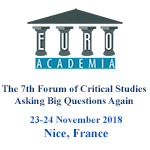Euroacademia Conferences
 Europe Inside-Out: Europe and Europeanness Exposed to Plural Observers (9th Edition) April 24 - 25, 2020
Europe Inside-Out: Europe and Europeanness Exposed to Plural Observers (9th Edition) April 24 - 25, 2020 Identities and Identifications: Politicized Uses of Collective Identities (9th Edition) June 12 - 13, 2020
Identities and Identifications: Politicized Uses of Collective Identities (9th Edition) June 12 - 13, 2020 8th Forum of Critical Studies: Asking Big Questions Again January 24 - 25, 2020
8th Forum of Critical Studies: Asking Big Questions Again January 24 - 25, 2020 Re-Inventing Eastern Europe (7th Edition) December 13 - 14, 2019
Re-Inventing Eastern Europe (7th Edition) December 13 - 14, 2019 The European Union and the Politicization of Europe (8th Edition) October 25 - 26, 2019
The European Union and the Politicization of Europe (8th Edition) October 25 - 26, 2019 Identities and Identifications: Politicized Uses of Collective Identities (8th Edition) June 28 - 29, 2019
Identities and Identifications: Politicized Uses of Collective Identities (8th Edition) June 28 - 29, 2019 The European Union and the Politicization of Europe (7th Edition) January 25 - 26, 2019
The European Union and the Politicization of Europe (7th Edition) January 25 - 26, 2019 7th Forum of Critical Studies: Asking Big Questions Again November 23 - 24, 2018
7th Forum of Critical Studies: Asking Big Questions Again November 23 - 24, 2018 Europe Inside-Out: Europe and Europeanness Exposed to Plural Observers (8th Edition) September 28 - 30, 2018
Europe Inside-Out: Europe and Europeanness Exposed to Plural Observers (8th Edition) September 28 - 30, 2018 Identities and Identifications: Politicized Uses of Collective Identities (7th Edition) June 14 - 15, 2018
Identities and Identifications: Politicized Uses of Collective Identities (7th Edition) June 14 - 15, 2018
Pompa Introitus Honori Serenissimi Principis Ferdinandi Austriaci Hispaniarum Infantis. Cardinal-Infante Don Ferdinand’s Triumphal Entry in Antwerp in 1635
-
-

-
Presentation speakers
- Laura García Sánchez, University of Barcelona, Spain
- Download presentation
Abstract:
On May 15, 1635, cardinal-infante don Ferdinand made his triumphal entry in Antwerp as the new governor of the Spanish Netherlands after his victory in Nördlingen against the Swedish and his allies of Saxony. The city, which was going through very delicate moments to maintain its previous commercial relevancy, decided to devote its economic and intellectual energies to this celebration with the aim of impressing don Ferdinand, from whom they were expecting protection. The tour that the cardinal-infante made through the city was masterfully decorated with five wooden twenty-two-meter-high triumphal arches, four stages – each, one with an allegoric program – and a portico, painted according to the program designed by Nicolaes Rockox, burgomaster; humanist Jean Gaspard Gevaerts, secretary of State; and Peter Paul Rubens, who designed, planned and executed these ephemeral decorations. Rubens, known for his management of delicate diplomatic missions in France, the Netherlands, England and Spain, was, lastly, the most important ideologist. The artist counted on the collaboration of Jacob Jordanes, Cornelis de Vos, Erasmus Quellenius, Gerard Seghers and Theodor van Thulden to carry out the paintings and the sculptures. For these works to remain in the future, several artists – led by Theodor van Thulden- were asked to engrave Rubens’ designs. Thus was Pompa introitus honori serenissimi principis Ferdinandi Austriaci Hispaniarum infantis born, a bibliographical jewel with forty-two etching prints, many of them in very big size. The copy discussed here, printed in vellum and illuminated by hand with great quality, has the date of 1641 in the colophon, but it was not published until the end of 1642, due to some delay of the text’s author. As consequence of the death of the cardinal-infante in 1641, the magistrate ordained that the book should not be dated later than the death of the protagonist of this work.
-
Related Presentations

Performing Lecture: Practice as Research (PaR)
- Jane Arnfield

Anamnesis: Dialogues of Art in Public Spaces
- Sandra Uskokovic

Scientific Visualisations of Urban Heritage as Identity Making Image Construction
- Dominik Lengyel
- Catherine Toulouse













